See Page 1 |
2 |
3 |
4 of the April 2022 homepage archives. Thursday the 21st
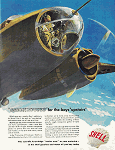 In the run-up to World War II and during
the battle, a lot of
plastics
research and production was considered classified defense information. Poly(methyl
methacrylate) (PMMA), also know by the trade names of Plexiglas, Lucite, Crystallite,
and others, was a crucial component for aircraft where the weight and brittleness
of regular glass made it practically useless (and dangerous). A full-page ad by
Shell Oil in this 1942 issue of Life magazine promoted plastic used in a bomber.
When I see this, it reminds me of "It's a Wonderful Life," where Sam Wainwright
offers George Bailey a position in his fledgling soybean-based plastic canopy factory
in Buffalo, New York. Being primarily a petroleum product, plastic was promoted
heavily by oil companies like Shell Oil, Standard Oil, American Oil, partially due
to patriotism, but no doubt also for the profits. Those places, of course, were
part of the "Military-Industrial Complex" identified by President Dwight Eisenhower.
In fact, an Internet search turns up many claims that those same companies conspired
to sell oil to Axis powers prior to America's official entry into WWII on December
7, 1941, when the Japanese bombed Pearl Harbor... In the run-up to World War II and during
the battle, a lot of
plastics
research and production was considered classified defense information. Poly(methyl
methacrylate) (PMMA), also know by the trade names of Plexiglas, Lucite, Crystallite,
and others, was a crucial component for aircraft where the weight and brittleness
of regular glass made it practically useless (and dangerous). A full-page ad by
Shell Oil in this 1942 issue of Life magazine promoted plastic used in a bomber.
When I see this, it reminds me of "It's a Wonderful Life," where Sam Wainwright
offers George Bailey a position in his fledgling soybean-based plastic canopy factory
in Buffalo, New York. Being primarily a petroleum product, plastic was promoted
heavily by oil companies like Shell Oil, Standard Oil, American Oil, partially due
to patriotism, but no doubt also for the profits. Those places, of course, were
part of the "Military-Industrial Complex" identified by President Dwight Eisenhower.
In fact, an Internet search turns up many claims that those same companies conspired
to sell oil to Axis powers prior to America's official entry into WWII on December
7, 1941, when the Japanese bombed Pearl Harbor...
 Rohde & Schwarz announces the launch
of the
R&S UMS400 universal monitoring system for spectrum monitoring and radiolocation
of frequencies from 8 kHz to 8 GHz (extendable up to 20 GHz with
the R&S CS-MC20 microwave converter). R&S UMS400 meets 8 GHz (optionally
20 GHz) monitoring station needs in the ever-increasing frequency ranges demanded
by wireless communications services. Before this latest Rohde & Schwarz innovation,
monitoring such a range meant the monitoring sensor had to be placed as close as
possible to the antenna for minimal cable losses and maximum sensitivity. R&S
UMS400 has a compact outdoor housing and low power consumption that makes it ideal
for temporary missions, such as event monitoring and radiolocation of sporadic interferers.
It allows a wide range of use cases, including fixed and mobile spectrum monitoring,
radiolocation of sporadic interference sources or short radio messages... Rohde & Schwarz announces the launch
of the
R&S UMS400 universal monitoring system for spectrum monitoring and radiolocation
of frequencies from 8 kHz to 8 GHz (extendable up to 20 GHz with
the R&S CS-MC20 microwave converter). R&S UMS400 meets 8 GHz (optionally
20 GHz) monitoring station needs in the ever-increasing frequency ranges demanded
by wireless communications services. Before this latest Rohde & Schwarz innovation,
monitoring such a range meant the monitoring sensor had to be placed as close as
possible to the antenna for minimal cable losses and maximum sensitivity. R&S
UMS400 has a compact outdoor housing and low power consumption that makes it ideal
for temporary missions, such as event monitoring and radiolocation of sporadic interferers.
It allows a wide range of use cases, including fixed and mobile spectrum monitoring,
radiolocation of sporadic interference sources or short radio messages...
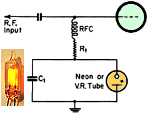 Neon bulbs used to show up in lots of commercial,
military, and consumer products, but have given way to LEDs because of efficiency
in cost, size, weight, and reliability. The 1950s-vintage radar I worked on in the
USAF used lots of them as indicators. Before the availability of Zener diodes, they
were used quite often as constant voltage references because of their characteristic
of maintaining a fairly steady voltage value over a wide range of currents. One
of the more useful tasks remaining for neon bulbs is for troubleshooting RF circuits
because of their ability to glow in the presence of a strong electromagnetic field
while only having physical contact with a single point in the circuit, or if the
field strength and frequency is accommodating, without any physical contact at all.
Some Ham radio operators still hang neon bulbs up on antenna masts where the feed
line interfaces to the antenna to use while adjusting impedance matching circuits
for maximum power transfer... Neon bulbs used to show up in lots of commercial,
military, and consumer products, but have given way to LEDs because of efficiency
in cost, size, weight, and reliability. The 1950s-vintage radar I worked on in the
USAF used lots of them as indicators. Before the availability of Zener diodes, they
were used quite often as constant voltage references because of their characteristic
of maintaining a fairly steady voltage value over a wide range of currents. One
of the more useful tasks remaining for neon bulbs is for troubleshooting RF circuits
because of their ability to glow in the presence of a strong electromagnetic field
while only having physical contact with a single point in the circuit, or if the
field strength and frequency is accommodating, without any physical contact at all.
Some Ham radio operators still hang neon bulbs up on antenna masts where the feed
line interfaces to the antenna to use while adjusting impedance matching circuits
for maximum power transfer...
 AutoDesk, the AutoCAD people, are offering
a free whitepaper entitled: "How to Prepare
Students for the Manufacturing and Engineering Jobs of Tomorrow." Technology
used in manufacturing and engineering is changing so quickly that industry is having
a hard time finding workers with the necessary skill sets. In fact, new research
shows that 30% of workers with mid-level skills will be obsolete by 2030. How can
you help your students succeed in an environment where employer needs are constantly
changing? Get the latest findings and put them into practice now. This new report
on Industry 4.0 reflects leading-edge research - and provides informed, actionable
recommendations. This report is your roadmap to a successful future for you and
your students. Download your free copy... AutoDesk, the AutoCAD people, are offering
a free whitepaper entitled: "How to Prepare
Students for the Manufacturing and Engineering Jobs of Tomorrow." Technology
used in manufacturing and engineering is changing so quickly that industry is having
a hard time finding workers with the necessary skill sets. In fact, new research
shows that 30% of workers with mid-level skills will be obsolete by 2030. How can
you help your students succeed in an environment where employer needs are constantly
changing? Get the latest findings and put them into practice now. This new report
on Industry 4.0 reflects leading-edge research - and provides informed, actionable
recommendations. This report is your roadmap to a successful future for you and
your students. Download your free copy...
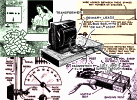 You might not have the need for a variable
capacitor made from a match box and a couple strips of tin foil, but there are plenty
of other "shortwave
kinks" offered here that could be of use to you when the preferred part is not
available. For instance, maybe a transformer exhibits an audible hum because of
improper construction, or maybe a vernier dial is needed for an adjustment knob;
homebrew solutions are offered for both. The adjustable capacitor idea is an "outside-and-inside-the-box"
solution (pun intended) that could come in handy. In all, there are 11 tips from
way back in 1935 offered by fellow radio enthusiasts, and printed in Short Wave
Craft magazine... You might not have the need for a variable
capacitor made from a match box and a couple strips of tin foil, but there are plenty
of other "shortwave
kinks" offered here that could be of use to you when the preferred part is not
available. For instance, maybe a transformer exhibits an audible hum because of
improper construction, or maybe a vernier dial is needed for an adjustment knob;
homebrew solutions are offered for both. The adjustable capacitor idea is an "outside-and-inside-the-box"
solution (pun intended) that could come in handy. In all, there are 11 tips from
way back in 1935 offered by fellow radio enthusiasts, and printed in Short Wave
Craft magazine...
/jobs.htm" target="_top">
 RF
Cafe's raison d'être is and always has been to provide useful, quality content for
engineers, technicians, engineering managers, students, and hobbyists. Part of that
mission is offering to post applicable /jobs.htm"
target="_top">job openings. HR department employees and/or managers of hiring
companies are welcome to submit opportunities for posting at no charge. 3rd party
recruiters and temp agencies are not included so as to assure a high quality of
listings. Please read through the easy procedure to benefit from RF Cafe's high
quality visitors... RF
Cafe's raison d'être is and always has been to provide useful, quality content for
engineers, technicians, engineering managers, students, and hobbyists. Part of that
mission is offering to post applicable /jobs.htm"
target="_top">job openings. HR department employees and/or managers of hiring
companies are welcome to submit opportunities for posting at no charge. 3rd party
recruiters and temp agencies are not included so as to assure a high quality of
listings. Please read through the easy procedure to benefit from RF Cafe's high
quality visitors...
 ASC designs and manufactures hybrid, surface
mount flange, open carrier and connectorized amplifiers for low, medium and high
power applications using gallium nitride (GaN), gallium arsenide (GaAs) and silicon
(Si) transistor technologies. ASC's thick film designs operate in the frequency
range of 300 kHz to 6 GHz. ASC offers thin film designs that operate up
to 20 GHz. ASC designs and manufactures hybrid, surface
mount flange, open carrier and connectorized amplifiers for low, medium and high
power applications using gallium nitride (GaN), gallium arsenide (GaAs) and silicon
(Si) transistor technologies. ASC's thick film designs operate in the frequency
range of 300 kHz to 6 GHz. ASC offers thin film designs that operate up
to 20 GHz.
Wednesday the 20th
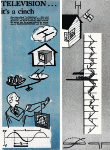 E. Aisberg wrote a series of columns
for Radio-Electronics magazine in the middle 1950s titled "Television...
It's a Cinch," informing the reading public about television in general and
the newly emerging color TV more specifically. He chose to use a unique dialog format
where two people were in a back-and-forth discussion about the technology. This
July installment is the first half of the seventeenth conversation. Antennas, tuned
circuits, component reliability, transmission lines, installation, and many other
aspects of successful television viewing are covered. The series began with the
February 1953 issue, and ran through October 1955. I will post the others as time
permits... E. Aisberg wrote a series of columns
for Radio-Electronics magazine in the middle 1950s titled "Television...
It's a Cinch," informing the reading public about television in general and
the newly emerging color TV more specifically. He chose to use a unique dialog format
where two people were in a back-and-forth discussion about the technology. This
July installment is the first half of the seventeenth conversation. Antennas, tuned
circuits, component reliability, transmission lines, installation, and many other
aspects of successful television viewing are covered. The series began with the
February 1953 issue, and ran through October 1955. I will post the others as time
permits...
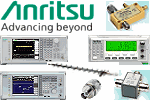 Anritsu has been a global provider of innovative
communications test and measurement solutions for more than 120 years. Anritsu manufactures
a full line of innovative components and accessories for
RF and Microwave Test and Measurement
Equipment including attenuators & terminations; coaxial cables, connectors &
adapters; o-scopes; power meters & sensors; signal generators; antenna, signal,
spectrum, & vector network analyzers (VNAs); calibration kits; Bluetooth &
WLAN testers; PIM testers; amplifiers; power dividers; antennas. Anritsu has been a global provider of innovative
communications test and measurement solutions for more than 120 years. Anritsu manufactures
a full line of innovative components and accessories for
RF and Microwave Test and Measurement
Equipment including attenuators & terminations; coaxial cables, connectors &
adapters; o-scopes; power meters & sensors; signal generators; antenna, signal,
spectrum, & vector network analyzers (VNAs); calibration kits; Bluetooth &
WLAN testers; PIM testers; amplifiers; power dividers; antennas.
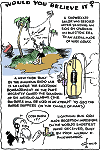 A regular feature in the ARRL's magazine
QST during the early days of radio was "New Receiving Tubes." It usually
had your standard editorial listing of products, but the May 1941 installment included
a comic commissioned my the
Magnolia Radio Lab people that is done in the manner of Ripley's Believe It
or Not. I'm guessing that there really is no Magnolia Radio Lab because nothing
came up on a fairly extensive Internet search for the company. Most good humor has
an element of truth in it that makes the subject matter believable - almost. These
three comics meet that criterion. "Gil - W1CJD" (aka Philip "Gil" Gildersleeve)
was the artist... A regular feature in the ARRL's magazine
QST during the early days of radio was "New Receiving Tubes." It usually
had your standard editorial listing of products, but the May 1941 installment included
a comic commissioned my the
Magnolia Radio Lab people that is done in the manner of Ripley's Believe It
or Not. I'm guessing that there really is no Magnolia Radio Lab because nothing
came up on a fairly extensive Internet search for the company. Most good humor has
an element of truth in it that makes the subject matter believable - almost. These
three comics meet that criterion. "Gil - W1CJD" (aka Philip "Gil" Gildersleeve)
was the artist...
 Modelithics is pleased to announce the release
of the latest version, v22.1, of the Modelithics COMPLETE Library for use with
Keysight Technologies' PathWave Advanced Design System (ADS). This version adds
a total of 26 new models for various components to the Modelithics COMPLETE Library.
With these new additions, the Modelithics COMPLETE Library now includes over 825
models that represent over 25,000 passive and active RF/microwave components. This
collection of simulation models comprises surface-mount RLC components, diodes,
transistors, amplifiers, attenuators, filters, couplers, and other components. Version
22.1 adds new scalable Microwave Global Models™ to the Modelithics COMPLETE Library,
including models for the 0201HL inductor series from Coilcraft, the 08051C capacitor
series from Kyocera-AVX, and the CBR04 and CBR06 automotive series from KEMET... Modelithics is pleased to announce the release
of the latest version, v22.1, of the Modelithics COMPLETE Library for use with
Keysight Technologies' PathWave Advanced Design System (ADS). This version adds
a total of 26 new models for various components to the Modelithics COMPLETE Library.
With these new additions, the Modelithics COMPLETE Library now includes over 825
models that represent over 25,000 passive and active RF/microwave components. This
collection of simulation models comprises surface-mount RLC components, diodes,
transistors, amplifiers, attenuators, filters, couplers, and other components. Version
22.1 adds new scalable Microwave Global Models™ to the Modelithics COMPLETE Library,
including models for the 0201HL inductor series from Coilcraft, the 08051C capacitor
series from Kyocera-AVX, and the CBR04 and CBR06 automotive series from KEMET...
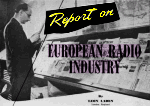 By 1946,
radio and television manufacturers were scurrying to supply the huge, pent-up
demand for communications and entertainment systems that accumulated during World
War II. Fortunately, the dearth of electronics components, raw materials for
chassis fabrication, and available labor was suddenly and significantly turned around
by late 1945. Wanton destruction of entire cities in Europe left citizens without
many basic creature comfort items like radios, televisions, refrigerators, vacuum
cleaners, toasters, automobiles, and other things taken for granted a decade earlier.
As with any well-executed plan, manufacturers endeavored to survey the market demand
for such products and then devised a way to satisfy that demand. Radio News
magazine published a synopsis in mid-1946 of the state of the radio and television
industry in Europe so that companies... By 1946,
radio and television manufacturers were scurrying to supply the huge, pent-up
demand for communications and entertainment systems that accumulated during World
War II. Fortunately, the dearth of electronics components, raw materials for
chassis fabrication, and available labor was suddenly and significantly turned around
by late 1945. Wanton destruction of entire cities in Europe left citizens without
many basic creature comfort items like radios, televisions, refrigerators, vacuum
cleaners, toasters, automobiles, and other things taken for granted a decade earlier.
As with any well-executed plan, manufacturers endeavored to survey the market demand
for such products and then devised a way to satisfy that demand. Radio News
magazine published a synopsis in mid-1946 of the state of the radio and television
industry in Europe so that companies...
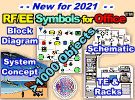 It was a lot of work, but I finally finished
a version of the "RF & Electronics Schematic & Block Diagram Symbols" that
works well with Microsoft Office™ programs Word™, Excel™, and Power Point™.
This is an equivalent of the extensive set of amplifier, mixer, filter, switch,
connector, waveguide, digital, analog, antenna, and other commonly used symbols
for system block diagrams and schematics created for Visio™. Each of the 1,000 or
so symbols was exported individually from Visio in the EMF file format, then imported
into Word on a Drawing Canvas. The EMF format allows an image to be scaled up or
down without becoming pixelated, so all the shapes can be resized in a document
and still look good. The imported symbols can also be UnGrouped into their original
constituent parts for editing. Check them out! It was a lot of work, but I finally finished
a version of the "RF & Electronics Schematic & Block Diagram Symbols" that
works well with Microsoft Office™ programs Word™, Excel™, and Power Point™.
This is an equivalent of the extensive set of amplifier, mixer, filter, switch,
connector, waveguide, digital, analog, antenna, and other commonly used symbols
for system block diagrams and schematics created for Visio™. Each of the 1,000 or
so symbols was exported individually from Visio in the EMF file format, then imported
into Word on a Drawing Canvas. The EMF format allows an image to be scaled up or
down without becoming pixelated, so all the shapes can be resized in a document
and still look good. The imported symbols can also be UnGrouped into their original
constituent parts for editing. Check them out!
 Exodus Advanced Communications is a multinational
RF communication equipment and engineering service company serving both commercial
and government entities and their affiliates worldwide. Power amplifiers ranging
from 10 kHz to 51 GHz with various output power levels and noise figure
ranges, we fully support custom designs and manufacturing requirements for both
small and large volume levels. decades of combined experience in the RF field for
numerous applications including military jamming, communications, radar, EMI/EMC
and various commercial projects with all designing and manufacturing of our HPA,
MPA, and LNA products in-house. Exodus Advanced Communications is a multinational
RF communication equipment and engineering service company serving both commercial
and government entities and their affiliates worldwide. Power amplifiers ranging
from 10 kHz to 51 GHz with various output power levels and noise figure
ranges, we fully support custom designs and manufacturing requirements for both
small and large volume levels. decades of combined experience in the RF field for
numerous applications including military jamming, communications, radar, EMI/EMC
and various commercial projects with all designing and manufacturing of our HPA,
MPA, and LNA products in-house.
Tuesday the 19th
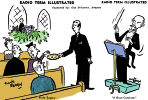 Here are a couple more of the much-liked
"Radio
Term Illustrated" comics, these appearing in the May 1947 issue of Radio-Craft
magazine. I probably spend way more time on colorizing these comics than I should.
You might think it's easy to just fill in areas with color, but most of the comics
are drawn in a manner where outlines of larger objects do not terminate against
another line. Being able to use a fill tool requires sealing off the area first.
Then there's the case of where an area uses a series of closely spaced lines or
cross-hatches. An area fill tool doesn't work well there, either, so the best way
I've found is to outline the area with a Bezier curve tool and copy / paste it over
itself so it is a separate object, then use a color transform tool to shift the
entire area to the chosen color. Even with all that work, the comics rarely turn
out the way I'd like them to... Here are a couple more of the much-liked
"Radio
Term Illustrated" comics, these appearing in the May 1947 issue of Radio-Craft
magazine. I probably spend way more time on colorizing these comics than I should.
You might think it's easy to just fill in areas with color, but most of the comics
are drawn in a manner where outlines of larger objects do not terminate against
another line. Being able to use a fill tool requires sealing off the area first.
Then there's the case of where an area uses a series of closely spaced lines or
cross-hatches. An area fill tool doesn't work well there, either, so the best way
I've found is to outline the area with a Bezier curve tool and copy / paste it over
itself so it is a separate object, then use a color transform tool to shift the
entire area to the chosen color. Even with all that work, the comics rarely turn
out the way I'd like them to...
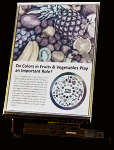 These reports on advances in ePaper technology
remind me of the 1990s as color computer monitors were ratcheting up pixel and color
count - first with CRTs and then LCD and LED flat panel displays. ePaper is a purely
reflective vs. back-lit display. "E Ink's digital paper, often called ePaper, has
found a home in e-readers, displays, and even covering cars. Balancing the need
for high-quality displays and power requirements has always been a challenge. It
started as a gray scale display, but color ePaper displays have been available for
a while. The latest generation, E Ink's Kaleido 3, takes the quality to a new level.
It can deliver 16 levels of gray scale and 4,096 colors. This new display increases
color saturation by 30% compared to the earlier Kaleido Plus. It can display animations
and videos. The Kaleido 3 employs a color filter array (CFA) that's used in conjunction
with E Ink's Carta black-and-white ink film. The display also uses the company's
ComfortGaze, a front-light technology designed by E Ink's Front Light Team. The
technology reduces the amount of blue light reflected off the surface of the display
and lowers the blue light ratio (BLR) by 60% and blue light toxicity factor (BLTF)
by 24%..." These reports on advances in ePaper technology
remind me of the 1990s as color computer monitors were ratcheting up pixel and color
count - first with CRTs and then LCD and LED flat panel displays. ePaper is a purely
reflective vs. back-lit display. "E Ink's digital paper, often called ePaper, has
found a home in e-readers, displays, and even covering cars. Balancing the need
for high-quality displays and power requirements has always been a challenge. It
started as a gray scale display, but color ePaper displays have been available for
a while. The latest generation, E Ink's Kaleido 3, takes the quality to a new level.
It can deliver 16 levels of gray scale and 4,096 colors. This new display increases
color saturation by 30% compared to the earlier Kaleido Plus. It can display animations
and videos. The Kaleido 3 employs a color filter array (CFA) that's used in conjunction
with E Ink's Carta black-and-white ink film. The display also uses the company's
ComfortGaze, a front-light technology designed by E Ink's Front Light Team. The
technology reduces the amount of blue light reflected off the surface of the display
and lowers the blue light ratio (BLR) by 60% and blue light toxicity factor (BLTF)
by 24%..."
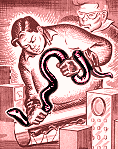 Wikipedia claims there are about 350 species
of electric fish. Jerry tells fellow electrical and electronics experimenter Carl
that the electric eel is not an eel at all, but a fish. Actually, the eel is a fish
(a knifefish); however - and I needed to look this up - a true eel is a member of
the fish order Anguilliformes, which the electric eel is not. Having no expertise
in the field of eels, I'll leave it at that. Jerry's uncle, who is an active duty
Navy guy, somehow managed to ship an electric eel to him for experimentation purposes.
Doing so might have been possible in 1956 when this episode of "Carl &
Jerry" appeared in Popular Electronics magazine, but today it is doubtful.
Besides that, how to you mail an electric eel to somebody? The pair's measurements
of voltages and pulse widths jive pretty well with modern data. Here is a story
about how electric eels curl to obtain higher voltages for stunning prey... Wikipedia claims there are about 350 species
of electric fish. Jerry tells fellow electrical and electronics experimenter Carl
that the electric eel is not an eel at all, but a fish. Actually, the eel is a fish
(a knifefish); however - and I needed to look this up - a true eel is a member of
the fish order Anguilliformes, which the electric eel is not. Having no expertise
in the field of eels, I'll leave it at that. Jerry's uncle, who is an active duty
Navy guy, somehow managed to ship an electric eel to him for experimentation purposes.
Doing so might have been possible in 1956 when this episode of "Carl &
Jerry" appeared in Popular Electronics magazine, but today it is doubtful.
Besides that, how to you mail an electric eel to somebody? The pair's measurements
of voltages and pulse widths jive pretty well with modern data. Here is a story
about how electric eels curl to obtain higher voltages for stunning prey...
 Some years ago while first developing my
"RF Cascade Workbook" spreadsheets, I read that when Microsoft began using the
XML file format for Excel with the 2007 version (Office 12), what appears
in the File Manager as a *.xls or *.xlsm (*.xls with VBA‡ macros) is actually a
compressed collection of individual XML files and possibly a *.bin and any images
you might have buried within. If you want to see what actually makes up your Excel
file, follow these simple instructions. A word of warning though, as Otto von Bismarck
is reported to have admonished†, "Laws are like sausages. It is better not to see
them being made." After seeing what goes into an Excel file, you might loose your
taste for them (not really, it just seemed like an apt quotation at the moment).
There may be another way to dissect an Excel file, but probably the easiest is the
following... Some years ago while first developing my
"RF Cascade Workbook" spreadsheets, I read that when Microsoft began using the
XML file format for Excel with the 2007 version (Office 12), what appears
in the File Manager as a *.xls or *.xlsm (*.xls with VBA‡ macros) is actually a
compressed collection of individual XML files and possibly a *.bin and any images
you might have buried within. If you want to see what actually makes up your Excel
file, follow these simple instructions. A word of warning though, as Otto von Bismarck
is reported to have admonished†, "Laws are like sausages. It is better not to see
them being made." After seeing what goes into an Excel file, you might loose your
taste for them (not really, it just seemed like an apt quotation at the moment).
There may be another way to dissect an Excel file, but probably the easiest is the
following...
 This "Radio Service Data Sheet" from a 1948
issue of Radio News provides schematics and parts lists for
Arvin
Models 152T and 153T receivers. Most - if not all - electronics servicemen had
subscriptions to these magazines because they were a ready source of not just these
service sheets, but because of the extensive articles offering advice on servicing
radios and televisions. In fact, many electronics manufacturers had a policy of
supplying service data only to bona fide shops. A large list is included at the
bottom of the page of similar documents from vintage receiver schematics, troubleshooting
tips, and alignment procedures. They were originally published in magazines like
Radio-Craft, Radio and Television News, Radio News, etc.
I scan and post them for the benefit of hobbyists who restore and service vintage
electronics equipment... This "Radio Service Data Sheet" from a 1948
issue of Radio News provides schematics and parts lists for
Arvin
Models 152T and 153T receivers. Most - if not all - electronics servicemen had
subscriptions to these magazines because they were a ready source of not just these
service sheets, but because of the extensive articles offering advice on servicing
radios and televisions. In fact, many electronics manufacturers had a policy of
supplying service data only to bona fide shops. A large list is included at the
bottom of the page of similar documents from vintage receiver schematics, troubleshooting
tips, and alignment procedures. They were originally published in magazines like
Radio-Craft, Radio and Television News, Radio News, etc.
I scan and post them for the benefit of hobbyists who restore and service vintage
electronics equipment...
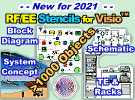 With more than 1000
custom-built stencils, this has got to be the most comprehensive set of
Visio Stencils available for RF, analog, and digital system and schematic
drawings! Every stencil symbol has been built to fit proportionally on the included
A-, B-, and C-size drawing page templates (or use your own page if preferred). Components
are provided for system block diagrams, conceptual drawings, schematics, test equipment,
racks (EIA 19", ETSI 21"), and more. Test equipment and racks are built at a 1:1
scale so that measurements can be made directly using Visio built-in dimensioning
objects. Page templates are provided with a preset scale (changeable) for a good
presentation that can incorporate all provided symbols... With more than 1000
custom-built stencils, this has got to be the most comprehensive set of
Visio Stencils available for RF, analog, and digital system and schematic
drawings! Every stencil symbol has been built to fit proportionally on the included
A-, B-, and C-size drawing page templates (or use your own page if preferred). Components
are provided for system block diagrams, conceptual drawings, schematics, test equipment,
racks (EIA 19", ETSI 21"), and more. Test equipment and racks are built at a 1:1
scale so that measurements can be made directly using Visio built-in dimensioning
objects. Page templates are provided with a preset scale (changeable) for a good
presentation that can incorporate all provided symbols...
 Withwave manufactures an extensive line of
metrology quality coaxial test cable assemblies, connectors (wave-, end-, vertical-launch,
board edge, panel mount), calibration kits (SOLT), a
fully automated
4-port vector network analyzer (VNA) calibrator, between- and in-series connector
adaptors, attenuators, terminations, DC blocks, torque wrenches, test probes &
probe positioner. Special test fixtures for calibration and multicoax cable assemblies.
Frequency ranges from DC through 110 GHz. Please contact Withwave today to
see how they can help your project succeed. Withwave manufactures an extensive line of
metrology quality coaxial test cable assemblies, connectors (wave-, end-, vertical-launch,
board edge, panel mount), calibration kits (SOLT), a
fully automated
4-port vector network analyzer (VNA) calibrator, between- and in-series connector
adaptors, attenuators, terminations, DC blocks, torque wrenches, test probes &
probe positioner. Special test fixtures for calibration and multicoax cable assemblies.
Frequency ranges from DC through 110 GHz. Please contact Withwave today to
see how they can help your project succeed.
Monday the 18th
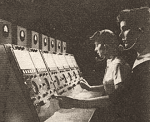 The
VOLSCAN (Volume Scanning) radar system was a paradigm changer for air traffic
controllers charges with guiding aircraft while assuring safe separation. Busy terminal
areas were a particularly difficult challenge due to the large variation in aircraft
speeds and types. VOLSCAN was a computer that tracked the position, direction, and
speed of each target and even made recommendations to controllers for course assignments.
It also warned of impending dangerous scenarios. Another VOLSCAN article in the
July 1954 issue of Radio-Electronics magazine went into more detail and had color
photos of the equipment. Interestingly, the equivalent of maybe the world's first
light pen computer interface is used by the operator for letting the processor know
what part of the screen (PPI, or plan position indicator) he is referring to... The
VOLSCAN (Volume Scanning) radar system was a paradigm changer for air traffic
controllers charges with guiding aircraft while assuring safe separation. Busy terminal
areas were a particularly difficult challenge due to the large variation in aircraft
speeds and types. VOLSCAN was a computer that tracked the position, direction, and
speed of each target and even made recommendations to controllers for course assignments.
It also warned of impending dangerous scenarios. Another VOLSCAN article in the
July 1954 issue of Radio-Electronics magazine went into more detail and had color
photos of the equipment. Interestingly, the equivalent of maybe the world's first
light pen computer interface is used by the operator for letting the processor know
what part of the screen (PPI, or plan position indicator) he is referring to...
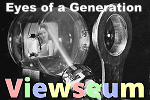 If ever there was a website that would likely
drag a radio and television broadcast historian down into the metaphorical rabbit
hole, "Eyes of
a Generation... Television's Living History" is it. Like Alice's experience
in Wonderland, once you enter the homepage porthole and begin clicking on links,
not only will getting back out be difficult, but the journey will introduce you
to many fantastic experiences in TV broadcasting which you have never seen before.
As the subtitle says, "In essence, this is a Television history book with 5000 stories,
10,000 rare photos and hundreds of one of a kind videos." If you are old enough
to remember way back to the 1980s and before, then you will find interesting tidbits
of insider and backstage anecdotes about all of the popular television shows of
the various eras - back to the very beginning. That includes sitcom, variety, and
news types. Included in the collection is a wealth of photographs and videos, along
with histories of the electronic equipment and its inventors that made it all possible.
You will also find never-seen-before film footage of live taping sessions, TV show
production, interviews, and documentaries. Did you know that David Letterman owned
the entire "Late Night" franchise... If ever there was a website that would likely
drag a radio and television broadcast historian down into the metaphorical rabbit
hole, "Eyes of
a Generation... Television's Living History" is it. Like Alice's experience
in Wonderland, once you enter the homepage porthole and begin clicking on links,
not only will getting back out be difficult, but the journey will introduce you
to many fantastic experiences in TV broadcasting which you have never seen before.
As the subtitle says, "In essence, this is a Television history book with 5000 stories,
10,000 rare photos and hundreds of one of a kind videos." If you are old enough
to remember way back to the 1980s and before, then you will find interesting tidbits
of insider and backstage anecdotes about all of the popular television shows of
the various eras - back to the very beginning. That includes sitcom, variety, and
news types. Included in the collection is a wealth of photographs and videos, along
with histories of the electronic equipment and its inventors that made it all possible.
You will also find never-seen-before film footage of live taping sessions, TV show
production, interviews, and documentaries. Did you know that David Letterman owned
the entire "Late Night" franchise...
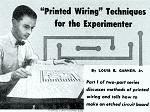 In part one of a two-part article, Popular
Electronics magazine presents some of the inner workings of what at the time was
a fledgling industry -
printed circuit board manufacturing. In 1956, when this piece appeared, a large
percentage of electronics assemblies were still being wired in a point-to-point
manner where resistors, capacitors, inductors, tubes, and cables were soldered directly
to terminals either on special blocks or on tube sockets. The process was heavily
labor intensive and prone to miswirings. High volume production was nearly impossible
prior to printed wiring boards (PWBs). Bell Telephone Labs was an early adopter
and driver of the technology. A good example of an early telephone PWB can be seen
in the 1970s vintage Snoopy telephone that I reconditioned a while back. Note the
rat's nest of wires going to the network terminal block... In part one of a two-part article, Popular
Electronics magazine presents some of the inner workings of what at the time was
a fledgling industry -
printed circuit board manufacturing. In 1956, when this piece appeared, a large
percentage of electronics assemblies were still being wired in a point-to-point
manner where resistors, capacitors, inductors, tubes, and cables were soldered directly
to terminals either on special blocks or on tube sockets. The process was heavily
labor intensive and prone to miswirings. High volume production was nearly impossible
prior to printed wiring boards (PWBs). Bell Telephone Labs was an early adopter
and driver of the technology. A good example of an early telephone PWB can be seen
in the 1970s vintage Snoopy telephone that I reconditioned a while back. Note the
rat's nest of wires going to the network terminal block...
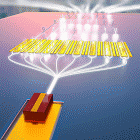 "For all the recent advances in integrated
lithium niobate photonic circuits - from frequency combs to frequency converters
and modulators - one big component has remained frustratingly difficult to integrate:
lasers. Long haul telecommunication networks, data center optical interconnects,
and microwave photonic systems all rely on lasers to generate an optical carrier
used in data transmission. In most cases, lasers are stand-alone devices, external
to the modulators, making the whole system more expensive and less stable and scalable.
Now, researchers from the Harvard John A. Paulson School of Engineering and Applied
Sciences (SEAS) in collaboration with industry partners at Freedom Photonics and
HyperLight Corporation, have developed the first fully integrated high-power laser
on a lithium niobate chip, paving the way for high-powered telecommunication systems,
fully integrated spectrometers..." "For all the recent advances in integrated
lithium niobate photonic circuits - from frequency combs to frequency converters
and modulators - one big component has remained frustratingly difficult to integrate:
lasers. Long haul telecommunication networks, data center optical interconnects,
and microwave photonic systems all rely on lasers to generate an optical carrier
used in data transmission. In most cases, lasers are stand-alone devices, external
to the modulators, making the whole system more expensive and less stable and scalable.
Now, researchers from the Harvard John A. Paulson School of Engineering and Applied
Sciences (SEAS) in collaboration with industry partners at Freedom Photonics and
HyperLight Corporation, have developed the first fully integrated high-power laser
on a lithium niobate chip, paving the way for high-powered telecommunication systems,
fully integrated spectrometers..."
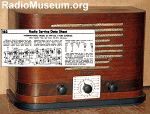 This "Radio Service Data Sheet" covers the
International Kadette Model 66 and 666, superheterodyne receiver. Most - if
not all - electronics servicemen had subscriptions to these magazines because they
were a ready source of not just these service sheets, but because of the extensive
articles offering advice on servicing radios and televisions. In fact, many electronics
manufacturers had a policy of supplying service data only to bona fide shops. A
large list is included at the bottom of the page of similar documents from vintage
receiver schematics, troubleshooting tips, and alignment procedures. They were originally
published in magazines like Radio-Craft (this April 1936 issue), Radio
and Television News, Radio News, etc. I scan and post them for the
benefit of hobbyists who restore and service vintage electronics equipment... This "Radio Service Data Sheet" covers the
International Kadette Model 66 and 666, superheterodyne receiver. Most - if
not all - electronics servicemen had subscriptions to these magazines because they
were a ready source of not just these service sheets, but because of the extensive
articles offering advice on servicing radios and televisions. In fact, many electronics
manufacturers had a policy of supplying service data only to bona fide shops. A
large list is included at the bottom of the page of similar documents from vintage
receiver schematics, troubleshooting tips, and alignment procedures. They were originally
published in magazines like Radio-Craft (this April 1936 issue), Radio
and Television News, Radio News, etc. I scan and post them for the
benefit of hobbyists who restore and service vintage electronics equipment...
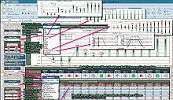 RF Cascade Workbook is the next phase in the evolution of
RF Cafe's long-running series, RF Cascade Workbook. Chances are you have
never used a spreadsheet quite like this (click here for screen capture). It is a full-featured RF system
cascade parameter and frequency planner that includes filters and mixers for a mere
$45. Built in MS Excel, using RF Cascade Workbook 2018 is a cinch
and the format is entirely customizable. It is significantly easier and faster than
using a multi-thousand dollar simulator when a high level system analysis is all
that is needed. An intro video takes you through the main features...
RF Cascade Workbook is the next phase in the evolution of
RF Cafe's long-running series, RF Cascade Workbook. Chances are you have
never used a spreadsheet quite like this (click here for screen capture). It is a full-featured RF system
cascade parameter and frequency planner that includes filters and mixers for a mere
$45. Built in MS Excel, using RF Cascade Workbook 2018 is a cinch
and the format is entirely customizable. It is significantly easier and faster than
using a multi-thousand dollar simulator when a high level system analysis is all
that is needed. An intro video takes you through the main features...
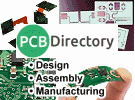 PCB Directory is the largest directory of
Printed Circuit
Board (PCB) Manufacturers, Assembly houses, and Design Services on the Internet.
We have listed the leading printed circuit board manufacturers around the world
and made them searchable by their capabilities - Number of laminates used, Board
thicknesses supported, Number of layers supported, Types of substrates (FR-4, Rogers,
flexible, rigid), Geographical location (U.S., China), kinds of services (manufacturing,
fabrication, assembly, prototype), and more. Fast turn-around on quotations for
PCB fabrication and assembly. PCB Directory is the largest directory of
Printed Circuit
Board (PCB) Manufacturers, Assembly houses, and Design Services on the Internet.
We have listed the leading printed circuit board manufacturers around the world
and made them searchable by their capabilities - Number of laminates used, Board
thicknesses supported, Number of layers supported, Types of substrates (FR-4, Rogers,
flexible, rigid), Geographical location (U.S., China), kinds of services (manufacturing,
fabrication, assembly, prototype), and more. Fast turn-around on quotations for
PCB fabrication and assembly.
Sunday the 17th
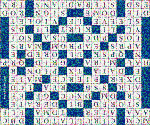 Here is your custom made
Technology-themed crossword puzzle for April 17th, 2022. All RF Cafe crossword
puzzles are custom made by me, Kirt Blattenberger, and have only words and clues
related to RF, microwave, and mm-wave engineering, optics, mathematics, chemistry,
physics, and other technical subjects. As always, this crossword contains no names
of politicians, mountain ranges, exotic foods or plants, movie stars, or anything
of the sort unless it/he/she is related to this puzzle's technology theme (e.g.,
Reginald Denny or the Tunguska event in Siberia). The technically inclined cruciverbalists
amongst us will appreciate the effort. Enjoy! Here is your custom made
Technology-themed crossword puzzle for April 17th, 2022. All RF Cafe crossword
puzzles are custom made by me, Kirt Blattenberger, and have only words and clues
related to RF, microwave, and mm-wave engineering, optics, mathematics, chemistry,
physics, and other technical subjects. As always, this crossword contains no names
of politicians, mountain ranges, exotic foods or plants, movie stars, or anything
of the sort unless it/he/she is related to this puzzle's technology theme (e.g.,
Reginald Denny or the Tunguska event in Siberia). The technically inclined cruciverbalists
amongst us will appreciate the effort. Enjoy!
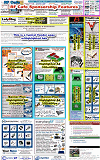 New Scheme rotates
all Banners in all locations on the page! RF Cafe typically receives 8,000-15,000
website visits each weekday.
RF Cafe is a favorite
of engineers, technicians, hobbyists, and students all over the world. With more
than 12,000 pages in the Google search index, RF Cafe returns in favorable
positions on many types of key searches, both for text and images. New content is
added on a daily basis, which keeps the major search engines interested enough to
spider it multiple times each day. Items added on the homepage often can be found
in a Google search within a few hours of being posted. I also re-broadcast homepage
items on LinkedIn. If you need your company news to be seen, RF Cafe is the
place to be. New Scheme rotates
all Banners in all locations on the page! RF Cafe typically receives 8,000-15,000
website visits each weekday.
RF Cafe is a favorite
of engineers, technicians, hobbyists, and students all over the world. With more
than 12,000 pages in the Google search index, RF Cafe returns in favorable
positions on many types of key searches, both for text and images. New content is
added on a daily basis, which keeps the major search engines interested enough to
spider it multiple times each day. Items added on the homepage often can be found
in a Google search within a few hours of being posted. I also re-broadcast homepage
items on LinkedIn. If you need your company news to be seen, RF Cafe is the
place to be.
 Empower RF Systems is a global leader in
power amplifier solutions. Empower RF Systems is an established and technologically
superior supplier of high power solid state RF & microwave amplifiers. Our offerings
include modules, intelligent rack-mount amplifiers, and multi-function RF Power
Amplifier solutions to 6 GHz in broadband and band specific designs. Output
power combinations range from tens of watts to multi-kilowatts. Unprecedented size,
weight and power reduction of our amplifiers is superior to anything in the market
at similar frequencies and power levels. Empower RF Systems is a global leader in
power amplifier solutions. Empower RF Systems is an established and technologically
superior supplier of high power solid state RF & microwave amplifiers. Our offerings
include modules, intelligent rack-mount amplifiers, and multi-function RF Power
Amplifier solutions to 6 GHz in broadband and band specific designs. Output
power combinations range from tens of watts to multi-kilowatts. Unprecedented size,
weight and power reduction of our amplifiers is superior to anything in the market
at similar frequencies and power levels.
Friday the 15th
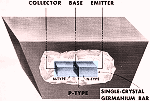 For many years, Radio-Electronics
magazine editor Hugo Gernsback and Audion tube inventor
Dr. Lee de Forest had sort of a mutual admiration society thing going
on. that's understandable because they we both men of great accomplishment and are
deserving of everyone's admiration. In this 1952 issue, Dr. de Forest
was invited to procrastinate on future of the transistor - the semiconductor equivalent
of his amplifying vacuum tube. He humbly states, "If in the year 1912 some editor
had requested of me an article on the 'Future of the Electronic Tube,' I probably
would have felt quite as incompetent and short-sighted a prophet of the developments
of that [...], as I feel today as Mr. Gernsback requests from me an outlook over
the future of the transistor, [the] possible successor of the grid tube." Less than
four yeas had passed since the Bell Labs trio announced their transistor invention,
but the technology advanced quickly once made known. History shows Dr. de Forest
was correct in predicting the vacuum tube and transistor (in all their various forms)
would coexist for a long time. It was not until the 1980s that solid state devices
had replaced nearly all tubes (except the CRT display)...For many years, Radio-Electronics
magazine editor Hugo Gernsback and Audion tube inventor Dr. Lee de Forest
had sort of a mutual admiration society thing going on. that's understandable because
they we both men of great accomplishment and are deserving of everyone's admiration... For many years, Radio-Electronics
magazine editor Hugo Gernsback and Audion tube inventor
Dr. Lee de Forest had sort of a mutual admiration society thing going
on. that's understandable because they we both men of great accomplishment and are
deserving of everyone's admiration. In this 1952 issue, Dr. de Forest
was invited to procrastinate on future of the transistor - the semiconductor equivalent
of his amplifying vacuum tube. He humbly states, "If in the year 1912 some editor
had requested of me an article on the 'Future of the Electronic Tube,' I probably
would have felt quite as incompetent and short-sighted a prophet of the developments
of that [...], as I feel today as Mr. Gernsback requests from me an outlook over
the future of the transistor, [the] possible successor of the grid tube." Less than
four yeas had passed since the Bell Labs trio announced their transistor invention,
but the technology advanced quickly once made known. History shows Dr. de Forest
was correct in predicting the vacuum tube and transistor (in all their various forms)
would coexist for a long time. It was not until the 1980s that solid state devices
had replaced nearly all tubes (except the CRT display)...For many years, Radio-Electronics
magazine editor Hugo Gernsback and Audion tube inventor Dr. Lee de Forest
had sort of a mutual admiration society thing going on. that's understandable because
they we both men of great accomplishment and are deserving of everyone's admiration...
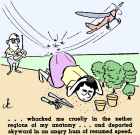 Based on beleaguered wife Sylvia Kohler's
mention of GE's Electronics Park in this story (surely a fable... or not), she and
unintentional antagonist, superheterodyne hubby (aka "Happy Boy," but we know him
as Popular Electronics cartoonist
Carl Kohler) probably lived in the Syracuse, New York, area. Electronics Park
(technically in Liverpool/Salina) existed during the hey days of General Electric
when the sprawling campus , just north of I-90, designed and manufactured a plethora
of both household (TVs and radios) and military electronics products. GE's Electronics
Laboratory ("E-Labs") was the company's pride and joy. Today, a tiny portion of
Electronics Park is still occupied by Lockheed Martin, who bought that GE division
in the 1990s, and the rest belongs the city. I worked there for about two years.
But I digress... enjoy the story (I highlighted her reason for referring to hubby
as a Superheterodyne)... Based on beleaguered wife Sylvia Kohler's
mention of GE's Electronics Park in this story (surely a fable... or not), she and
unintentional antagonist, superheterodyne hubby (aka "Happy Boy," but we know him
as Popular Electronics cartoonist
Carl Kohler) probably lived in the Syracuse, New York, area. Electronics Park
(technically in Liverpool/Salina) existed during the hey days of General Electric
when the sprawling campus , just north of I-90, designed and manufactured a plethora
of both household (TVs and radios) and military electronics products. GE's Electronics
Laboratory ("E-Labs") was the company's pride and joy. Today, a tiny portion of
Electronics Park is still occupied by Lockheed Martin, who bought that GE division
in the 1990s, and the rest belongs the city. I worked there for about two years.
But I digress... enjoy the story (I highlighted her reason for referring to hubby
as a Superheterodyne)...
 Reactel, industry leaders in the design and
manufacture of RF and Microwave filters, diplexers, and sub-assemblies from DC to
67 GHz, recently produced a new video short on
Waveguide
Filters. Benefits of waveguide filters include very low insertion loss, extremely
narrow bandwidths, high power handling, and very sharp band edge rolloff. Custom
sizes and shapes are available, along with many variations on duplexers, diplexers,
multiplexers, switched filter banks, and other configurations. Many off-the-shelf
products are available, and Reactel engineers are happy to assist you with determining
your system's needs and designing filters to help you succeed. Please take a couple
minutes to view this video, then give Reactel a call. Reactel, industry leaders in the design and
manufacture of RF and Microwave filters, diplexers, and sub-assemblies from DC to
67 GHz, recently produced a new video short on
Waveguide
Filters. Benefits of waveguide filters include very low insertion loss, extremely
narrow bandwidths, high power handling, and very sharp band edge rolloff. Custom
sizes and shapes are available, along with many variations on duplexers, diplexers,
multiplexers, switched filter banks, and other configurations. Many off-the-shelf
products are available, and Reactel engineers are happy to assist you with determining
your system's needs and designing filters to help you succeed. Please take a couple
minutes to view this video, then give Reactel a call.
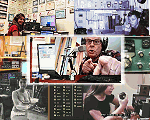 The "Up Front" page of the May 2022 issue
of QST magazine mentions a musical tribute to ham radio entitled, "Back
on the Air," by Allen Chance (W2BUZ) and Paul Rogers. It has a soothing melody
and the video is accompanied by photos matching the lyrics as it goes along. You
probably have to be a Ham operator to appreciate the message and visuals. A repeating
CW CW CW in Morse code
can be heard in the background. Warning: If you are easily triggered by a couple
"guy" pictures, this video is not for you; please move on... The "Up Front" page of the May 2022 issue
of QST magazine mentions a musical tribute to ham radio entitled, "Back
on the Air," by Allen Chance (W2BUZ) and Paul Rogers. It has a soothing melody
and the video is accompanied by photos matching the lyrics as it goes along. You
probably have to be a Ham operator to appreciate the message and visuals. A repeating
CW CW CW in Morse code
can be heard in the background. Warning: If you are easily triggered by a couple
"guy" pictures, this video is not for you; please move on...
 Maybe I suffer from cranial rectumitis at
the moment, but I'm having a hard time with a statement made in this 1953 issue
of QST magazine about coaxial feedline impedance, to wit, "102-ohm line
(52-ohm lines in series)." I must be missing something because I don't understand
how placing two 52-ohm transmission cables in series results in twice the impedance.
Aside from that, author John Avery presents an interesting article on
multi-impedance
dipole antennas. Empirical data is presented on how the feed−point impedance
of a dipole varies with distance above the ground. His results are very close to
theoretical values which assumes non-sagging elements, perfectly linear alignment,
a perfectly conductive ground, etc. He then extended his investigation into 2-wire
(4x impedance) and 3-wire (9x impedance) folded dipole antennas... Maybe I suffer from cranial rectumitis at
the moment, but I'm having a hard time with a statement made in this 1953 issue
of QST magazine about coaxial feedline impedance, to wit, "102-ohm line
(52-ohm lines in series)." I must be missing something because I don't understand
how placing two 52-ohm transmission cables in series results in twice the impedance.
Aside from that, author John Avery presents an interesting article on
multi-impedance
dipole antennas. Empirical data is presented on how the feed−point impedance
of a dipole varies with distance above the ground. His results are very close to
theoretical values which assumes non-sagging elements, perfectly linear alignment,
a perfectly conductive ground, etc. He then extended his investigation into 2-wire
(4x impedance) and 3-wire (9x impedance) folded dipole antennas...
 It was a lot of work, but I finally finished
a version of the "RF & Electronics Schematic & Block Diagram Symbols" that
works well with Microsoft Office™ programs Word™, Excel™, and Power Point™.
This is an equivalent of the extensive set of amplifier, mixer, filter, switch,
connector, waveguide, digital, analog, antenna, and other commonly used symbols
for system block diagrams and schematics created for Visio™. Each of the 1,000 or
so symbols was exported individually from Visio in the EMF file format, then imported
into Word on a Drawing Canvas. The EMF format allows an image to be scaled up or
down without becoming pixelated, so all the shapes can be resized in a document
and still look good. The imported symbols can also be UnGrouped into their original
constituent parts for editing. Check them out! It was a lot of work, but I finally finished
a version of the "RF & Electronics Schematic & Block Diagram Symbols" that
works well with Microsoft Office™ programs Word™, Excel™, and Power Point™.
This is an equivalent of the extensive set of amplifier, mixer, filter, switch,
connector, waveguide, digital, analog, antenna, and other commonly used symbols
for system block diagrams and schematics created for Visio™. Each of the 1,000 or
so symbols was exported individually from Visio in the EMF file format, then imported
into Word on a Drawing Canvas. The EMF format allows an image to be scaled up or
down without becoming pixelated, so all the shapes can be resized in a document
and still look good. The imported symbols can also be UnGrouped into their original
constituent parts for editing. Check them out!
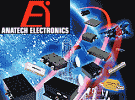 Anatech Electronics (AEI) manufactures and
supplies RF and microwave filters for military and commercial communication
systems, providing standard LP, HP, BP, BS, notch, diplexer, and custom RF filters,
and RF products. Standard RF filter and cable assembly products are published in
our website database for ease of procurement. Custom RF filters designs are used
when a standard cannot be found, or the requirements dictate a custom approach for
your military and commercial communications needs. Sam Benzacar's monthly newsletters
address contemporary wireless subjects. Please visit Anatech today to see how they
can help your project succeed. Anatech Electronics (AEI) manufactures and
supplies RF and microwave filters for military and commercial communication
systems, providing standard LP, HP, BP, BS, notch, diplexer, and custom RF filters,
and RF products. Standard RF filter and cable assembly products are published in
our website database for ease of procurement. Custom RF filters designs are used
when a standard cannot be found, or the requirements dictate a custom approach for
your military and commercial communications needs. Sam Benzacar's monthly newsletters
address contemporary wireless subjects. Please visit Anatech today to see how they
can help your project succeed.
These archive pages are provided in order to make it easier for you to find items
that you remember seeing on the RF Cafe homepage. Of course probably the easiest
way to find anything on the website is to use the "Search
RF Cafe" box at the top of every page.
About RF Cafe.
Homepage Archive Pages
2024:
Jan |
Feb |
Mar |
Apr |
May |
Jun |
Jul |
Aug |
Sep |
Oct |
Nov |
Dec
2023:
Jan |
Feb |
Mar |
Apr |
May |
Jun |
Jul |
Aug |
Sep |
Oct |
Nov |
Dec
2022:
Jan |
Feb |
Mar |
Apr |
May |
Jun |
Jul |
Aug |
Sep |
Oct |
Nov |
Dec
2021:
Jan |
Feb |
Mar |
Apr |
May |
Jun |
Jul |
Aug |
Sep |
Oct |
Nov |
Dec
2020:
Jan |
Feb |
Mar |
Apr |
May |
Jun |
Jul |
Aug |
Sep |
Oct |
Nov |
Dec
2019:
Jan |
Feb |
Mar |
Apr |
May |
Jun |
Jul |
Aug |
Sep |
Oct |
Nov |
Dec
2018:
Jan |
Feb |
Mar |
Apr |
May |
Jun |
Jul |
Aug |
Sep |
Oct |
Nov |
Dec
2017:
Jan | Feb |
Mar |
Apr |
May |
Jun |
Jul |
Aug |
Sep |
Oct |
Nov |
Dec
2016:
Jan |
Feb |
Mar |
Apr |
May |
Jun |
Jul |
Aug |
Sep |
Oct |
Nov |
Dec
2015:
Jan |
Feb |
Mar |
Apr |
May |
Jun |
Jul |
Aug |
Sep |
Oct |
Nov |
Dec
2014:
Jan |
Feb |
Mar |
Apr |
May |
Jun |
Jul |
Aug |
Sep |
Oct |
Nov |
Dec
2013:
Jan |
Feb |
Mar |
Apr |
May |
Jun |
Jul |
Aug |
Sep |
Oct |
Nov |
Dec
2012:
1 |
2 |
3 |
4 |
5 |
6 |
7 |
8 |
9 |
10 |
11 |
12 |
13 (no archives before 2012)
|


 Neon bulbs
Neon bulbs

 RF
Cafe's raison d'être is and always has been to provide useful, quality content for
engineers, technicians, engineering managers, students, and hobbyists. Part of that
mission is offering to post applicable /jobs.htm"
target="_top">job openings. HR department employees and/or managers of hiring
companies are welcome to submit opportunities for posting at no charge. 3rd party
recruiters and temp agencies are not included so as to assure a high quality of
listings. Please read through the easy procedure to benefit from RF Cafe's high
quality visitors...
RF
Cafe's raison d'être is and always has been to provide useful, quality content for
engineers, technicians, engineering managers, students, and hobbyists. Part of that
mission is offering to post applicable /jobs.htm"
target="_top">job openings. HR department employees and/or managers of hiring
companies are welcome to submit opportunities for posting at no charge. 3rd party
recruiters and temp agencies are not included so as to assure a high quality of
listings. Please read through the easy procedure to benefit from RF Cafe's high
quality visitors...






 Exodus Advanced Communications
Exodus Advanced Communications















 Empower RF Systems
Empower RF Systems




